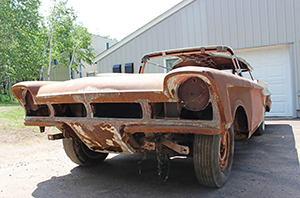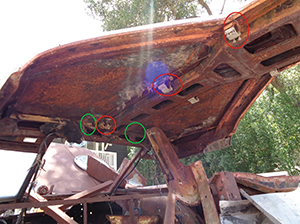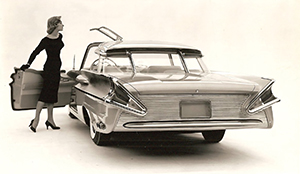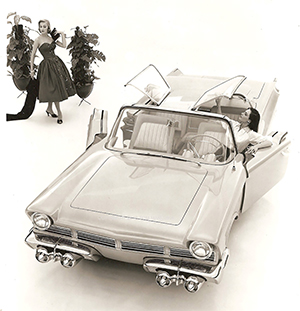Restoration begins on 1956 Turnpike Cruiser concept
Sometime in April of 1954, Ford Motor Co. designer John Najjar made a proposal to build a couple new show cars, one of which was the XM Turnpike Cruiser.
For those who don’t know, the “XM” stands for eXperimental Mercury.
Najjar was also the key designer of the 1954 Mercury XM-800 concept car that I restored a few years ago.
Unfortunately, no one in its past ownership history, including the Mercury Division of Ford Motor Co., took care of this important design concept vehicle.
It sat outside its entire life after the show circuit of 1956, exposed to the harsh climate of Detroit, Mich.,in its early years, and then in California’s relentess sun until I purchased it in the summer of 2018.
While sitting outside in the back parking lot at Ford’s headquarters, vandals broke the door windows, allowing the elements to get in the car and begin its deterioriation.
 If you look at the early pictures of the XM-TC in its prime, you’ll notice that the hood “peak” is barely noticeable. Look again at the current pictures with the replacement hood, and you’ll see that the peak is quite enhanced from the original version.
If you look at the early pictures of the XM-TC in its prime, you’ll notice that the hood “peak” is barely noticeable. Look again at the current pictures with the replacement hood, and you’ll see that the peak is quite enhanced from the original version.
I intend to completely fabricate a new hood in the original style during the restoration.
The XM-TC evidently had a few rust holes in the front of the quarter panels, just ahead of the rear wheels on both sides.
The hood was apparently damaged or rusted beyond repair at some point, as a replacement hood was fabricated by one of the former owners who owned a body shop.
The condition of the repairs to the quarters and to the replacement hood are a testament to the quality of workmanship the XM-TC has received under prior ownerships.
 At right, notice the “butterfly” roof sections over the driver and passenger seats, These are clear plexiglass sections that open automatically when the doors are opened, and close again automatically when the doors are closed.
At right, notice the “butterfly” roof sections over the driver and passenger seats, These are clear plexiglass sections that open automatically when the doors are opened, and close again automatically when the doors are closed.
They are activated by micro switches in the door jambs and are powered by electric motors at the rear of the roof under the headliner panel, which are connected to the “butterflys” by drive shafts.
The XM-TC was lower than any car of its era, which was done to give more headroom getting in and out of the car.
A 1955 Mercury coupe rolling chassis was sent from Ford to Ghia Carozzeria in Italy to construct the XM-TC on top of. Ford also sent along a 3/8 plaster scale model for Ghia to work off of.
Ghia built the XM-TC from the chassis up. In other words, the chassis was first modified to accomodate the plans for the car in that there was an extension added to the rear of the chassis because the XM-TC was to be longer than any production car of the day.
 It was also built much lower than any other production car of the day, standing only 52.4 inches high. This was accomplished in part by cutting approximately four inches off the top of the chassis at the foot well areas.
It was also built much lower than any other production car of the day, standing only 52.4 inches high. This was accomplished in part by cutting approximately four inches off the top of the chassis at the foot well areas.
Cutting that much out of the chassis would severly weaken it and surely cause problems, such as doors binding.
This was compensated for by adding additional frame rails inboard from the main rails. These new rails were on either side of the drive shaft.
The new structure was added and then the floors were welded into place on the new chassis. The rest of the body was subsequently built from there on up.
There was also additional strengthening structure added at other areas under the floor.
In order to begin the restoration, I have to separate the body from the chassis. To accomplish that, I’ll first weld trusses inside the body to keep it rigid while I cut the floors away so I can separate them.
I have a rust-free 1955 Mercury Coupe chassis to use for the restoration and I’ll modify that to match the original and build the floors on top, as Ghia did in 1955.
As you can see, I have my work cut out for me.
Ed. Note: Tom has many more images of the original and current XM-TC on his website at www.tommaruskacars.us. There is also video footage dating back to 1956 showing the car on tour with the Big M Van-O-Rama.


